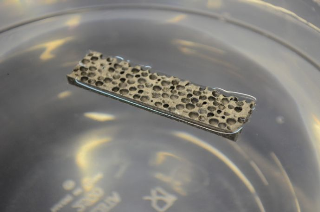May 14 2015
Researchers from Deep Springs Technology (DST) and the New York University Polytechnic School of Engineering have developed a new lightweight metal matrix composite that could find applications as vehicle armor, in buoyancy modules, automobile parts and boat flooring.
 Researchers have developed the lightest weight metal matrix foam--light enough to float on water in a beaker in the NYU laboratory of Dr. Nikhil Gupta
Researchers have developed the lightest weight metal matrix foam--light enough to float on water in a beaker in the NYU laboratory of Dr. Nikhil Gupta
Syntactic foams have been in use for a long time. However, this is the first time a lightweight metal matrix syntactic foam has been developed using them. The lightweight characteristics of the new material allow it to float on water, hence a boat formed of this material may not be submerged even if there is structural damage to it. Furthermore, the combination of heat resistance and light weight, enables the material to improve fuel economy in automobiles.
When silicon carbide hollow particles are added to the material, the composite has a density of 0.92g/cc versus 1g/cc of water. This enables the material to tolerate extreme conditions in marine environments.
In recent years, continuous efforts had been made to develop lightweight polymer matrix composites that serve as an alternative to heavier metal-based components in marine vessels and automobiles. This new composite technology is nearing maturation, and the prototypes can be tested in three years. The researchers say that the high buoyancy and lightness enables the new syntactic foams to be used in amphibious vehicles such as the Ultra Heavy-lift Amphibious Connector (UHAC) being developed by the U.S. Marine Corps.
This new development of very light metal matrix composites can swing the pendulum back in favor of metallic materials. The ability of metals to withstand higher temperatures can be a huge advantage for these composites in engine and exhaust components, quite apart from structural parts.
Nikhil Gupta
Professor in the Department of Mechanical and Aerospace Engineering - NYU School of Engineering
Co-author of the Study
Although the syntactic foam is light in weight, it provides substantial strength. It is formed by developing a magnesium alloy matrix which is then added with strong, lightweight silicon carbide hollow spheres produced by DST to convert into foam. The shell of the single sphere can tolerate more than 25,000psi pressure prior to its rupture, which is nearly hundred times the pressure existing in a fire hose.
Further, the hollow particles protect the syntactic foam from impact as each shell absorbs energy during damage. Based on the application requirements, the metal matrix can be added with specific number of shells either fewer or more to customize the density and other characteristics of the composite. This concept can be applied on other non-flammable magnesium alloys as well.
The findings of the study titled “Dynamic Properties of Silicon Carbide Hollow Particle Filled Magnesium Alloy (AZ91D) Matrix Syntactic Foams” were published in the International Journal of Impact Engineering. The research was carried out in collaboration with the U.S. Army Research Laboratory.